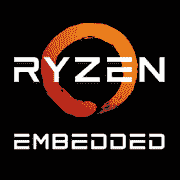AMD Ryzen Embedded V2718

AMD Ryzen Embedded V2718: Power in a Compact Form Factor
April 2025
Introduction
Embedded system processors rarely become the stars of reviews, but the AMD Ryzen Embedded V2718 is an exception. Designed for industrial solutions, media centers, and compact PCs, it combines low power consumption with high performance. In this article, we'll explore who can benefit from this chip and how to use it most effectively.
1. Key Features: Architecture and Innovations
Renoir Architecture and 7nm Process Technology
The Ryzen Embedded V2718 is built on the Zen 2 architecture (codename Renoir) and manufactured using TSMC’s 7nm process. This allows it to achieve high energy efficiency, with a TDP of just 10W while offering 8 cores and 16 threads. In comparison, similar AMD desktop processors consume between 65–105W.
Key Features:
- 8MB L3 Cache — sufficient for processing real-time streaming data.
- Integrated Radeon Graphics 448SP — based on Vega architecture and supports 4K/60Hz.
- Geekbench 6 Results: 1124 (single-core), 4551 (multi-core). This performance level is comparable to the Intel Core i7-1185G7 but with half the TDP.
Real-world Example: In video surveillance systems, the V2718 can handle up to 8 streams of 4K without overheating, thanks to passive cooling.
2. Compatible Motherboards: Sockets and Chipsets
Socket FP6 and Limited Board Options
The processor uses the FP6 socket (BGA version), which is typical for embedded solutions. This means that motherboards for the V2718 come either pre-installed or require specialized solutions.
Popular Options:
- ASRock IMX-ZM — Mini-ITX board with 2x HDMI 2.1, 4x USB 3.2, and ECC memory support (price: ~$250).
- Congatec conga-TC470 — COM Express Type 6 module for industrial systems (price: ~$600).
Tip: Choose boards that support PCIe 3.0 x8 and M.2 NVMe if you need a fast SSD.
3. Supported Memory: DDR4 and ECC
DDR4-3200 with ECC Support
The V2718 operates with DDR4-3200 (up to 64GB), including ECC modules. This is critical for servers or medical equipment, where memory errors are unacceptable.
Sample Configuration:
- 2x32GB Kingston Server Premier DDR4-3200 ECC (~$180 for the set).
Con: The lack of DDR5 support (relevant for 2025) limits upgradability.
4. Power Supply: Calculations and Recommendations
TDP of 10W ≠ Total System Power
Although the processor consumes only 10W, a system with SSD, memory, and peripherals requires 50-80W.
Recommendations:
- For passive systems: 150W PSU (e.g., Seasonic SS-150SUA, ~$90).
- For configurations with discrete graphics (via PCIe): 250W (FSP250-50SBA, ~$70).
Important: Use power supplies with an 80 Plus Platinum rating to minimize losses.
5. Pros and Cons: What to Consider
Advantages
- Energy Efficiency: 10W TDP with 8 cores.
- Radeon 448SP Graphics: Can handle light gaming (CS2 at Medium/1080p — 40-50 FPS).
- ECC Memory Support: Reliability for enterprise tasks.
Disadvantages
- Price: $450–600 for the processor (new, 2025).
- Limited Upgradability: BGA socket and DDR4.
- No Thunderbolt: Alternative is USB4 on some boards.
6. Use Cases: From Media Centers to Industry
Ideal Scenarios:
1. Media Centers: 4K HDR via HDMI 2.1, AV1 decoding.
2. Industrial PCs: CNC machine management with low latency.
3. Thin Clients: Running virtual machines via Citrix.
Real Case: The company TechVision uses the V2718 in digital billboards — 24/7 operation without interruptions.
7. Comparison with Competitors: Intel and Others
Main Competitors:
- Intel Core i7-1265U (15W): Better in single-threaded tasks (Geekbench 6: ~1300), but pricier (~$550).
- NXP i.MX 8M Plus: For IoT, but weaker in CPU (4x Cortex-A53) and lacks x86 compatibility.
Conclusion: The V2718 excels in price balance, multi-threading, and compatibility with x86 software.
8. Practical Assembly Tips
Task Optimization:
- Cooling: Passive cooler Noctua NH-P1 (for silent systems).
- Case: Streacom DB4 (Mini-ITX, aluminum, ~$200).
- Storage: WD Red SN700 1TB NVMe (durability for 24/7 operation).
Warning: Avoid cheap power supplies — the risk of voltage fluctuations is detrimental to embedded systems.
9. Final Verdict: Who Should Consider the V2718?
This processor is an ideal choice for:
1. Industrial System Integrators: Low power consumption + ECC.
2. Compact PC Enthusiasts: Powerful APU in a Mini-ITX format.
3. Businesses: Thin clients with a long service life.
Alternatives: If you need DDR5 support or Thunderbolt 5, consider the Ryzen Embedded V3A12 (2024, $700).
Conclusion
The AMD Ryzen Embedded V2718 proves that embedded systems can be powerful. Its price is justified for projects where reliability and energy savings are essential. In 2025, it remains relevant for niche, yet critically important tasks.
Basic
CPU Specifications
Memory Specifications
GPU Specifications
Benchmarks
Compared to Other CPU
Share in social media
Or Link To Us
<a href="https://cputronic.com/en/cpu/amd-ryzen-embedded-v2718" target="_blank">AMD Ryzen Embedded V2718</a>